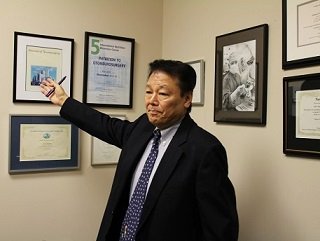Medical
2018.02.05
Dr. Fukushima Interview
World-renowned neurosurgeon, Dr. Takanori Fukushima,
talks about the wonder of Ikegami camera technology
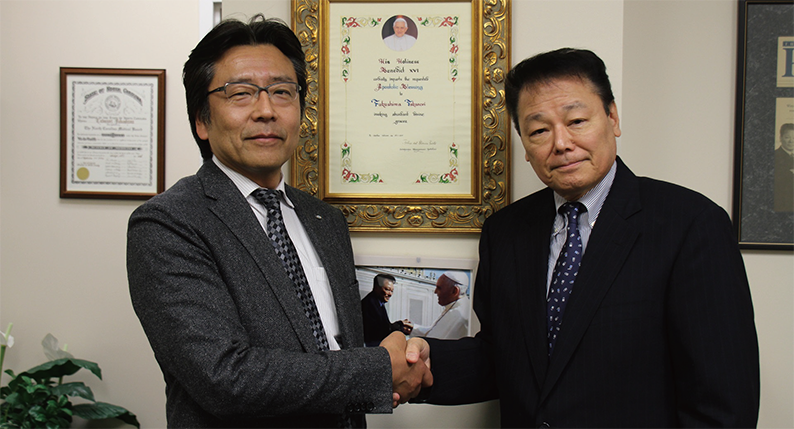
January 12, 2018 : At Carolina Neuroscience Institute (Raleigh, North Carolina, U.S.A.), Mr.Kashimura, Director of Ikegami Tsushinki, talked to neurosurgeon Dr.Takanori Fukushima about Ikegami cameras.
Kashimura: “I heard that you have had a very long relationship with Ikegami. Can you tell me how this relationship began?”
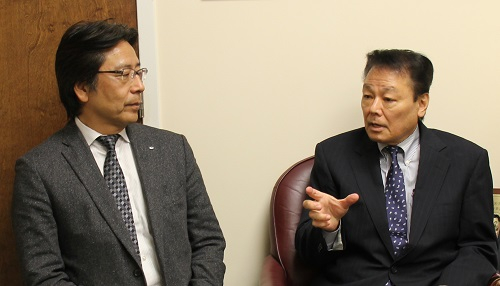
(Left: Ikegami/Kashimura, Right: Dr.Fukushima)
Dr. Fukushima:
“It was 40 years ago, after finishing my first overseas work in 1978. The hospital I returned to in Japan was using a single-tube video camera at that time for microscopy. From that time on, I endeavored to create my own surgical technique using a high-performance camera, and I wanted to distribute the best surgical images to the world. After researching available camera technology, I encountered the Ikegami medical video camera MKC series, which was using three tubes for surgical microscopy at the time. The hospital immediately purchased the camera.”
Kashimura: “Please tell us what has impressed you the most about your relationship with Ikegami.”
Dr. Fukushima:
“It was probably the first time I saw the picture of Ikegami’s three-tube video camera. The “beautiful” impression still remains. Most notably, the camera’s ability to reproduce the color red was very impressive. When I introduced the surgical video using the Ikegami camera combined with my surgical technique at a conference presentation, I remember vividly the fact that the venue was silent.
It supported the shooting of keyhole surgery (Dime surgery*) which was the technique I devised at that time. An American professor who saw the vividly recorded video of my breakthrough surgical procedure, came to Japan to observe the actual surgery.
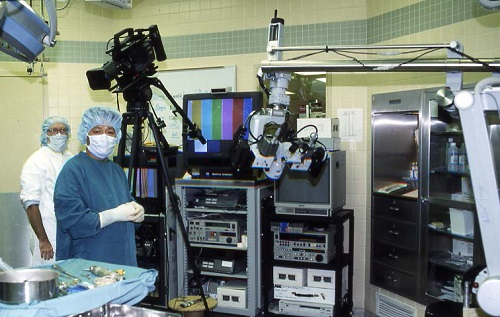
3D camera LK series
2x camera heads (silver color) on arm
After that, I also exchanged opinions with the development manager of Ikegami and I remember well that I used the stereoscopic images captured by the developed 3D video camera LK series at the conference. It may have been a pioneer of medical 3D images.”
(*Dr. Fukushima’s Dime surgery is a technique that minimizes the range of craniotomy necessary for neuro surgery and minimizes the patient’s physical burden and risk.
Kashimura: “What are your feelings about Ikegami’s products today?”
Dr.Fukushima:
“I am currently using Ikegami’s full HD camera. I’m very satisfied with the sensitivity and color reproduction, especially red color reproduction. Although I tried to compare it with other companies’ 4K cameras, I felt Ikegami’s image was overwhelmingly better despite being an HD camera. Also, I think that after-sales service, including rapid response, sets Ikegami apart from the competition.”
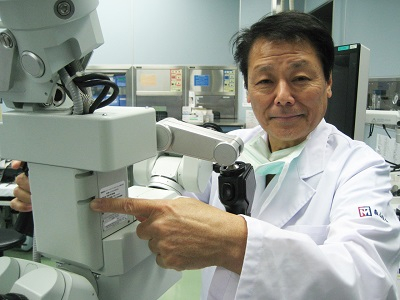
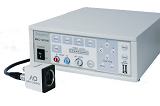
Surgical microscope with MKC-500HD MKC-500HD Full HD camera
Kashimura: “Ikegami Tsushinki is currently focusing on the development of 8K / 4K cameras. Moving forward, what kind of contribution can the imaging equipment provide to neurosurgery, and also what do you expect from the future of video equipment?”
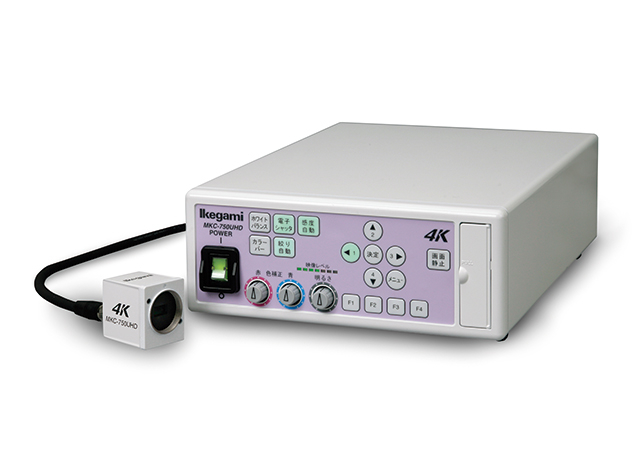
MKC-750UHD
High resolution 4K camera
Dr. Fukushima:
“I expect higher resolution cameras. We want you to contribute to further medical development by pursuing technology of high definition as full HD, 4K, even 8K.”
In summary, we received the message from Dr. Fukushima to Ikegami Tsushinki.
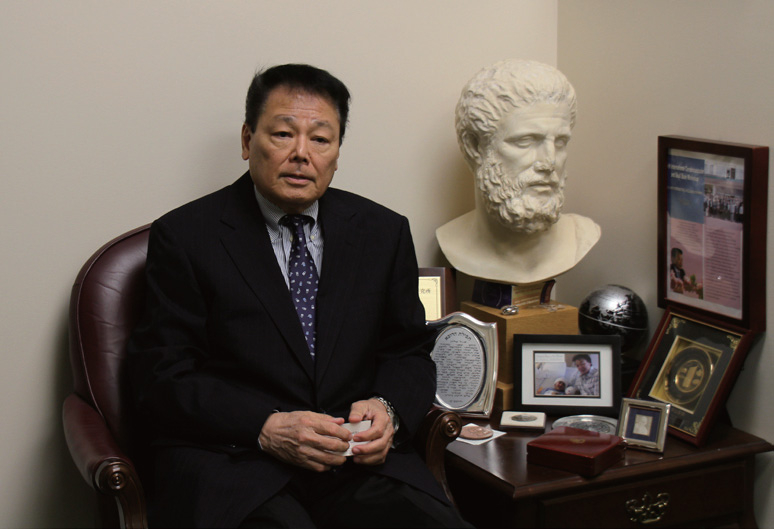
In summary, we received the message from Dr. Fukushima to Ikegami Tsushinki.
“After all, the essence of Ikegami is broadcasting cameras. As a video professional, I want you to continue to show a firm presence for broadcasting cameras that require high quality. And in the medical market, we want to seek higher definition such as promotion of 4 K and unquestionably demonstrate its technical capabilities in the medical field.
I think that Ikegami is a good place to make full use of development power and innovative ideas. Please pursue making better things than other companies, and focus on ‘making the best in Japan, the best in the world,’ to disseminate to the whole world.”
Dr. Fukushima’s career
- Born 1942 in Tokyo.
- Graduated from the University of Tokyo School of Medicine in 1968 and began his neurosurgical training at the University of Tokyo Hospital. Developed the world’s first neuroendoscopy in his first year of residency and gained the attention of the world at the age of 27.
- Associate of the University of Berlin Steglitz Clinic Neurosurgery Research of Germany, and the U.S. Mayo Clinic Neurosurgery clinical research. He served as an assistant at the University of Tokyo Hospital Neurosurgery from 1978 to 1980. In 1980 he became the director at Mitsui Memorial Hospital Neurosurgery.
- Dr. Fukushima participated in establishing the skull base surgery program at the UCLA Department of Neurosurgery from 1989-1990.
- He was appointed to the University of Southern California Medical Center, Professor of Neurosurgery in 1991. The U.S. granted him a permanent residence visa.
- In 1994, he served at the Pennsylvania Medical College Allegheny General Hospital as a Neurosurgery Professor and a director at the Institute of Neurological Surgery at Allegheny Skull Base Surgery Center. While touring all around the world for surgery and lectures, he holds skull base surgery training seminars.
- He became a Professor at Duke University Neurosurgery and started Carolina Skull Base Surgery Center 1998. Currently, he founded Carolina Neuroscience Institute.
- Dr. Fukushima is described by many as “The nation’s top influence” of neurosurgery microscopic surgery. He is a visiting professor at the Karolinska Institute in Sweden, Honorary Professor of the University of Marseille, France, University of Rome, Italy.
(Above was cited from “Website of neurosurgeon Takanori Fukushima” http://takanorifukushima.com/)
